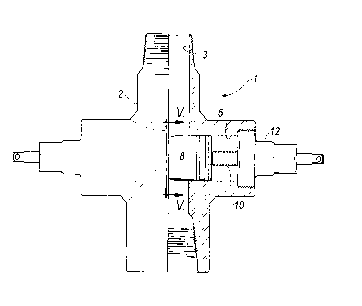Une partie des informations de ce site Web a été fournie par des sources externes. Le gouvernement du Canada n'assume aucune responsabilité concernant la précision, l'actualité ou la fiabilité des informations fournies par les sources externes. Les utilisateurs qui désirent employer cette information devraient consulter directement la source des informations. Le contenu fourni par les sources externes n'est pas assujetti aux exigences sur les langues officielles, la protection des renseignements personnels et l'accessibilité.
L'apparition de différences dans le texte et l'image des Revendications et de l'Abrégé dépend du moment auquel le document est publié. Les textes des Revendications et de l'Abrégé sont affichés :
| (12) Brevet: | (11) CA 2177629 |
|---|---|
| (54) Titre français: | OBTURATEUR A MACHOIRES POUR TETE DE PUITS |
| (54) Titre anglais: | WELLHEAD PRODUCTION BLOWOUT PREVENTER RAM |
| Statut: | Durée expirée - au-delà du délai suivant l'octroi |
| (51) Classification internationale des brevets (CIB): |
|
|---|---|
| (72) Inventeurs : |
|
| (73) Titulaires : |
|
| (71) Demandeurs : |
|
| (74) Agent: | |
| (74) Co-agent: | |
| (45) Délivré: | 1999-09-21 |
| (22) Date de dépôt: | 1996-05-29 |
| (41) Mise à la disponibilité du public: | 1997-11-30 |
| Requête d'examen: | 1996-05-29 |
| Licence disponible: | S.O. |
| Cédé au domaine public: | S.O. |
| (25) Langue des documents déposés: | Anglais |
| Traité de coopération en matière de brevets (PCT): | Non |
|---|
| (30) Données de priorité de la demande: | S.O. |
|---|
La couche de caoutchouc sur la mâchoire d'obturateur est renforcée aux points de scellement en formant des nervures sur l'âme de la mâchoire d'obturateur. Les nervures permettent à la bande de caoutchouc de résister à l'extrusion lorsque le bloc obturateur de puits est soumis à des pressions élevées dans le puits.
The rubber layer on the ram is reinforced at the sealing areas by forming
ribs on the ram core. The ribs function to resist extrusion of the rubber layer when the
blowout preventer is subjected to high pressure from the well.
Note : Les revendications sont présentées dans la langue officielle dans laquelle elles ont été soumises.
Note : Les descriptions sont présentées dans la langue officielle dans laquelle elles ont été soumises.

2024-08-01 : Dans le cadre de la transition vers les Brevets de nouvelle génération (BNG), la base de données sur les brevets canadiens (BDBC) contient désormais un Historique d'événement plus détaillé, qui reproduit le Journal des événements de notre nouvelle solution interne.
Veuillez noter que les événements débutant par « Inactive : » se réfèrent à des événements qui ne sont plus utilisés dans notre nouvelle solution interne.
Pour une meilleure compréhension de l'état de la demande ou brevet qui figure sur cette page, la rubrique Mise en garde , et les descriptions de Brevet , Historique d'événement , Taxes périodiques et Historique des paiements devraient être consultées.
| Description | Date |
|---|---|
| Exigences relatives à la révocation de la nomination d'un agent - jugée conforme | 2020-09-01 |
| Inactive : Périmé (brevet - nouvelle loi) | 2016-05-29 |
| Requête visant le maintien en état reçue | 2013-05-22 |
| Inactive : Lettre officielle | 2007-03-14 |
| Inactive : Paiement correctif - art.78.6 Loi | 2007-01-17 |
| Requête d'examen reçue | 2000-04-06 |
| Inactive : Correspondance - Formalités | 2000-04-06 |
| Accordé par délivrance | 1999-09-21 |
| Inactive : Page couverture publiée | 1999-09-20 |
| Préoctroi | 1999-06-10 |
| Inactive : Taxe finale reçue | 1999-06-10 |
| Un avis d'acceptation est envoyé | 1999-03-19 |
| Lettre envoyée | 1999-03-19 |
| Un avis d'acceptation est envoyé | 1999-03-19 |
| Inactive : Renseign. sur l'état - Complets dès date d'ent. journ. | 1999-03-15 |
| Inactive : Dem. traitée sur TS dès date d'ent. journal | 1999-03-15 |
| Inactive : Approuvée aux fins d'acceptation (AFA) | 1999-02-15 |
| Demande publiée (accessible au public) | 1997-11-30 |
| Exigences pour une requête d'examen - jugée conforme | 1996-05-29 |
| Toutes les exigences pour l'examen - jugée conforme | 1996-05-29 |
Il n'y a pas d'historique d'abandonnement
Le dernier paiement a été reçu le 1999-05-25
Avis : Si le paiement en totalité n'a pas été reçu au plus tard à la date indiquée, une taxe supplémentaire peut être imposée, soit une des taxes suivantes :
Veuillez vous référer à la page web des taxes sur les brevets de l'OPIC pour voir tous les montants actuels des taxes.
Les titulaires actuels et antérieures au dossier sont affichés en ordre alphabétique.
| Titulaires actuels au dossier |
|---|
| STREAM-FLO INDUSTRIES LTD. |
| Titulaires antérieures au dossier |
|---|
| KEITH D. FARQUHARSON |
| TONY M. LAM |